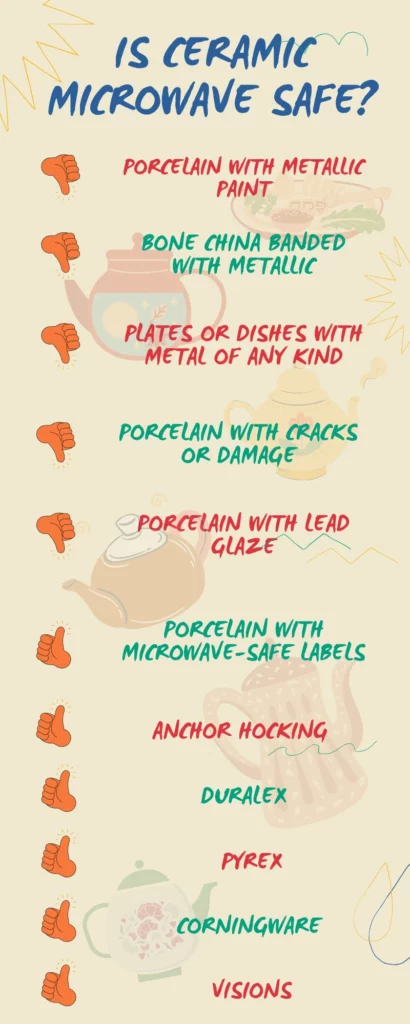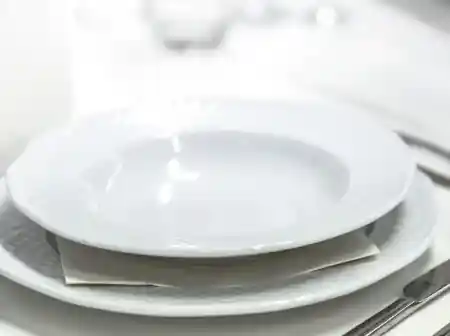Is Ceramic Microwave Safe?
Porcelain plates with no metallic decorations and have the microwave safe symbol are perfectly safe to put into the microwave. Porcelain plates having paint conducting decorations and lead glazes are damaged by being microwaved. Microwaving porcelain plates with metallic decorations of any kind should be avoided. The paint used for decorations will spark in the microwave.
| Porcelain with metallic paint | Not Safe |
| Bone china banded with metallic | Not Safe |
| Plates or dishes with metal of any kind | Not Safe |
| Porcelain with cracks or damage | Not Safe |
| If you are not sure | Not Safe |
| Porcelain with lead glaze | Not Safe |
| Porcelain with microwave-safe labels | Safe |
| Anchor Hocking | Safe |
| Duralex | Safe |
| Pyrex | Safe |
| Corningware | Safe |
| Visions | Safe |

Are All Porcelain Microwave Safe?
Porcelain plates are safe (that have no metallic decorations and have the safe symbol) to put into the microwave. As a result, porcelain and ceramic can easily withstand the heat of a microwave without being damaged. During the firing process for porcelain temperatures of up to and over 2,650 degrees Fahrenheit are used. These temperatures are much higher than any microwave oven temperature can produce.

My advice is do not put anything in the microwave you really care about.
Ed Shears
What Are The 3 Types Of Ceramics? – Ceramic or pottery may be divided into three categories: Earthenware, stoneware, and porcelain.
My personal experience is I’ve had cups where the handles have fallen off after repeated microwave use and other supposedly microwave safe bowls and plates that get so hot you can’t touch them. The standard answer is to look for the microwave safe symbol but my opinion based on first hand knowledge is if you care about it, don’t do it.
Microwave Cautions
As mentioned above you should be cautious, although porcelain is perfectly safe in the microwave however plates decorated with metallic paint, gold leaf and or silver strips should not be microwaved. No matter what you put into the microwave make sure you handle it with caution. Some plates like bone china gets hot in the microwave and if course if ever in doubt don’t put it in the microwave. Like most of us at some time or another we have all put something in the microwave that shouldn’t go there. And once the electric arcs began we quickly unplugged the microwave to keep from further damage. The end result of the mishap was a mess to clean up. And hopefully no damaged occurred to the microwave.
How Do You Know Is A Bowl Is Microwave Safe?
Most porcelain dishes come with a microwave-safe label from their manufacturers. I always look for the microwave safe symbol before put any plate in the microwave.

Porcelain, Fine China And Ceramics
The term porcelain refers to a wide range of ceramic items that have been baked at high temperatures to achieve vitreous or glassy properties, such as translucent and low porosity. Table and decorative china, chemical products, dental crowns and electrical insulators are among the most popular porcelain products. Generally white or gray, porcelain comes in both glazed and unglazed varieties, cooked at high temperatures, representing the most common unglazed type.
Although porcelain is often used as a Chinese synonym, the two are not identical. Both complement each other in that both are extremely low-porosity glassware, and both can be glazed or unglazed. However, the porcelain, also known as soft paste or tender porcelain, is softer: it can be cut with a file, while porcelain can not be cut.
This difference is due to the higher temperatures at which true porcelain is fired, 2.650 degrees Fahrenheit (1.454 degrees Celsius) compared to 2.200 degrees Fahrenheit (1.204 degrees Celsius) for Chinese. Due to its higher hardness, porcelain has some medical and industrial applications that China does not have, limited to domestic and artistic uses. Moreover, while porcelain is always translucent, porcelain is opaque.
Earlier in the 18th century, the English built on the porcelain recipe when they invented bone china by applying ash from cow bones to clay, feldspar and quartz. While bone china is fired at lower temperatures than real porcelain, bone ash still makes it translucent. Because it’s easier to make, harder to crack, and stronger than hard porcelain, bone china has become the most popular type of porcelain in the United States.
Porcelain, Microwave And Lead Glazes
Porcelain is a heat-resistant material, and after baking at a high temperature of more than 1000 degrees, there are no problems with microwaving. Whether a porcelain plate is safe to use in a microwave depends on its decoration and other facts like if it has a lead glaze.
After bisque-firing a glazes are usually applied. Bisque-firing is when the porcelain parts are heated to vaporize moisture and minimize shrinkage during firing. A glaze is applied to the bisque be means of painting, pouring, dipping and or spraying. When I apply glaze it is always painted on and not poured, dipped or sprayed. To me if it’s not hand painted it’s not art and becomes more of a manufactured process in which I am not interested in. That’s just my opinion others I am sure could disagree.
Many old porcelain pieces have lead glazes. This is one of the traditional types of glazed earthenware. And of course as we all know The Romans used lead glazes for high-quality oil lamps and drinking cups. Modern glazes have no lead. I no not use lead glazes.
Glazes are used on earthenware to make item impervious to liquids. Plain lead glaze becomes glossy and clear after firing. Colored lead glazes are shiny and either transparent or opaque after firing. Three other traditional techniques are tin-glazed, which cover the ware with opaque white glazing appropriate for brush-painted enamel designs, salt-glazed earthenware, such as stoneware, and feldspar glazed Asian porcelain. Modern materials technology has invented new glazes that do not fall into these traditional categories. For example, like Duncan glazes which are generally low fire glazes and do not contain lead.
Many ceramic products are use for cooking, storing and serving foods. It’s impossible just by looking at dishware to know if it has a lead glaze. However some types are much more likely to have lead. Here are a few examples:
- Classic glazed Terra Cotta (or clay) dishware made in certain Latin American countries, such as bean pots in Mexico.
- Antique tableware distributed to families or found in antique shops, markets and garages.
- Traditional, highly decorated dishes used in some Asian communities.
More On Porcelain Glaze

Tints are created by impurities in lead glazes render greenish to brownish casts, with aesthetic possibilities which are not easily controlled in the kiln. For high quality oil lamps and drinking cups the Romans used lead glazes. At the same time in China, green-glazed pottery dating back to the Han dynasty (25–220 AD) eventually gave rise to the ceramics of the’ sancai’ or three-color Tang Dynasty, where the white clay body was coated with colored glazes and fired around 800 degrees C. Lead oxide was the dominant flux in the glaze; polychrome results were achieved by using copper (which turns green), iron (brownish yellow and blue), and less commonly manganese oxides.
References
Lerdprom, W., Zapata-Solvas, E., Jayaseelan, D. D., Borrell, A., Salvador, M. D., & Lee, W. E. (2017). Impact of microwave processing on porcelain microstructure. Ceramics International, 43(16), 13765-13771. sciencedirect.com/science/article/pii/S0272884217315201





